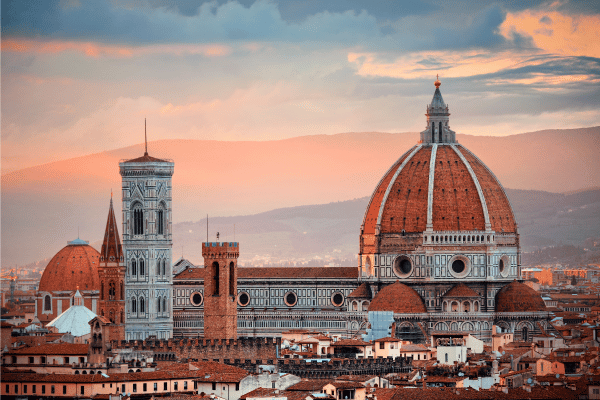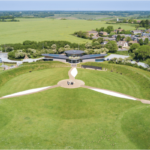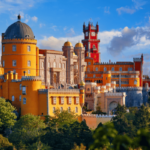Welcome to our journey through Florence’s enchanting streets, where each corner reveals a story. Explore Florence’s Renaissance Gems with our guide to the city’s most mesmerizing sights.
A Stroll Through Florence’s Historic Heart

Florence, the cradle of the Renaissance, offers a tapestry of art, architecture, and history. Its streets, lined with ancient buildings, lead to magnificent piazzas. Each step in this historic city is a leap back in time. Here, travelers experience a unique blend of art and life. Explore Florence’s Renaissance Gems and discover how this city revolutionized the world. Its artistic heritage is not just in galleries, but all around, in the very fabric of the city.
The city’s charm lies in its ability to seamlessly integrate the old with the new. Modern boutiques nestle in centuries-old structures, while traditional trattorias serve local delicacies under frescoed ceilings. Florence’s allure transcends time, as each era leaves an indelible mark. Exploring these streets, one not only sees, but also feels the Renaissance spirit. Florence invites you to explore its Renaissance gems, offering a vivid journey through history, culture, and unparalleled beauty.
Florence’s artistic influence radiates beyond its borders, having ignited a cultural rebirth across Europe. The city’s legacy is reflected in its stunning landmarks, like the Duomo, Uffizi Gallery, and Ponte Vecchio. These icons not only showcase artistic prowess but also tell stories of a city that shaped the course of history. To truly explore Florence’s Renaissance gems, one must immerse in its culture, relishing the blend of historical magnificence and contemporary vibrancy.
The Duomo: Florence’s Architectural Crown
The Duomo, officially known as the Cattedrale di Santa Maria del Fiore, stands as Florence’s most iconic landmark. Its massive dome, engineered by Filippo Brunelleschi, is a marvel of Renaissance architecture. As you explore Florence’s Renaissance gems, the Duomo’s intricate façade and towering presence leave an indelible impression. Its grandeur not only dominates the city’s skyline but also symbolizes Florence’s artistic and cultural prominence during the Renaissance era.
Visitors are mesmerized by the Duomo’s interior, adorned with exquisite frescoes and intricate designs. Climbing to the top of the dome offers a panoramic view of Florence, a breathtaking experience blending art, history, and beauty. The journey upwards, through narrow corridors, is a voyage through time. It’s here, within these ancient walls, that one truly connects with the Renaissance spirit. Each step brings you closer to understanding why to explore Florence’s Renaissance gems is essential.
The Duomo’s significance extends beyond its architectural feats. It represents human ingenuity and the era’s quest for knowledge and beauty. This cathedral is more than a religious symbol; it’s a testament to the city’s enduring influence on art and culture. Exploring this masterpiece, one can’t help but feel a part of something greater—a historical narrative that continues to inspire. Truly, to explore Florence’s Renaissance gems begins with the awe-inspiring Duomo.
Uffizi Gallery: A Renaissance Art Haven
The Uffizi Gallery, a cornerstone in Florence’s artistic landscape, houses an unparalleled collection of Renaissance art. Walking its halls, one embarks on an artistic journey through time. Here, masterpieces by Botticelli, Leonardo, and Michelangelo not only showcase artistic genius but also tell the story of a transformative era. As you explore Florence’s Renaissance gems, the Uffizi offers a window into the minds and talents that shaped the Renaissance, making it a must-visit destination.
Each room in the Uffizi Gallery reveals a different chapter of art history. From the ethereal beauty of Botticelli’s “Birth of Venus” to the striking details in Leonardo’s sketches, these works evoke a deep sense of awe. The gallery’s architecture, with its long corridors and grand windows, complements the art within, creating a harmonious environment. To explore Florence’s Renaissance gems is to wander through these galleries, absorbing the richness of Renaissance art.
Beyond its artistic significance, the Uffizi Gallery reflects Florence’s historical and cultural evolution. It stands as a testament to the Medici family’s patronage, which fueled the Renaissance’s artistic endeavors. Exploring this space, visitors gain insight into the societal and political influences behind these masterpieces. The Uffizi isn’t just an art gallery; it’s a journey into a past world, encouraging everyone to explore Florence’s Renaissance gems and their enduring legacy.
Ponte Vecchio: Explore Florence’s Timeless Bridge

Ponte Vecchio, Florence’s oldest bridge, is a symbol of enduring strength and beauty. This medieval stone bridge, adorned with jewelry shops, spans the Arno River with grace. As you explore Florence’s Renaissance gems, Ponte Vecchio offers a picturesque journey into the city’s past. It’s a place where history lingers in the air, and the vibrant bustle of modern life intersects with the echoes of centuries gone by, creating a truly magical atmosphere.
Strolling across Ponte Vecchio is like walking through a living museum. The bridge’s unique structure and the array of shops date back to the Renaissance, offering a glimpse into Florence’s mercantile history. The view from the bridge, overlooking the Arno, is simply breathtaking. It’s a spot where artists and lovers gather, drawn by the bridge’s romantic allure. To explore Florence’s Renaissance gems includes experiencing the timeless charm of Ponte Vecchio.
Ponte Vecchio’s significance extends beyond its architectural charm. During World War II, it was the only bridge in Florence spared from destruction, a testament to its cultural importance. Today, it stands as a bridge between eras, connecting the city’s rich history with its present-day vitality. A visit here isn’t just a step back in time; it’s a celebration of resilience and beauty. Explore Florence’s Renaissance gems by starting at this iconic bridge.
Boboli Gardens: Nature’s Renaissance Masterpiece
The Boboli Gardens, a splendid example of Renaissance landscape architecture, offer a serene escape from Florence’s bustling streets. This expansive green haven behind the Pitti Palace is a masterful blend of art and nature. As you explore Florence’s Renaissance gems, the Boboli Gardens provide a unique perspective on Renaissance design, merging manicured lawns, sculptures, and fountains in a harmonious layout that invites contemplation and admiration, amidst the backdrop of Florence’s stunning scenery.
Strolling through these gardens, visitors are treated to a visual feast. The pathways lead to hidden grottos, ornate sculptures, and elaborate fountains, each element carefully placed to enhance the garden’s beauty. The Boboli Gardens are not just a green space; they’re a living art gallery, showcasing the Renaissance’s influence on landscape design. To explore Florence’s Renaissance gems includes experiencing the tranquility and artistic genius of these magnificent gardens.
Beyond their aesthetic appeal, the Boboli Gardens hold historical significance. They reflect the Medici family’s vision and power, as they transformed Florence into a Renaissance capital. Today, the gardens serve as a cultural and recreational hub for locals and tourists alike. They offer a peaceful retreat where history, art, and nature intersect beautifully. A visit to the Boboli Gardens is essential to fully explore Florence’s Renaissance gems, embracing the city’s rich artistic legacy.
Palazzo Vecchio: A Legacy of Florentine Power

Palazzo Vecchio, with its imposing structure and rich history, stands as a testament to Florence’s political and cultural might. This fortress-like palace, dominating the Piazza della Signoria, encapsulates the essence of Florentine governance and art. As you explore Florence’s Renaissance gems, Palazzo Vecchio offers an insightful glimpse into the city’s past, showcasing remarkable art and architecture that reflect the political intrigue and artistic vibrancy of Renaissance Florence.
Inside, the Palazzo Vecchio astonishes with lavish rooms and stunning frescoes. The Hall of the Five Hundred, with its grand scale and intricate decorations, is particularly awe-inspiring. Each room tells a story, revealing the ambitions and achievements of Florence’s rulers. Exploring these spaces, visitors connect with the city’s historical narrative. To explore Florence’s Renaissance gems includes delving into the Palazzo Vecchio’s layers of history, art, and power.
Beyond its historical and artistic significance, Palazzo Vecchio remains a symbol of Florentine resilience. Its tower, offering panoramic views, allows visitors to gaze upon the city that once was the heart of the Renaissance. The Palazzo’s enduring presence in Florence’s main square speaks to its central role in the city’s past and present. A visit here is not just a tour of a historical building; it’s an immersion into the soul of Florence.
Accademia Gallery: Home of the David
The Accademia Gallery, renowned worldwide for housing Michelangelo’s David, is a treasure trove of Renaissance art. This gallery, though smaller than the Uffizi, packs a powerful punch with its focused collection. As you explore Florence’s Renaissance gems, the Accademia provides an intimate experience with masterpieces that shaped art history. The highlight, undoubtedly, is the David, a sculpture that epitomizes the ideals of Renaissance beauty and humanism.
Beyond the David, the Accademia Gallery showcases an array of sculptures and paintings that capture the Renaissance spirit. Each piece tells a story, reflecting the artistic innovation of the time. The gallery’s layout encourages a personal connection with the works, allowing visitors to appreciate the finer details. To explore Florence’s Renaissance gems at the Accademia is to understand the depth and breadth of Renaissance creativity and its enduring influence on art and culture.
The Accademia Gallery also offers insights into the artistic process. Michelangelo’s unfinished “Prisoners” provide a rare glimpse into the sculptor’s method, revealing the struggle between raw marble and the emerging form. This connection with the artist’s hand adds a layer of fascination to the gallery experience. Visiting the Accademia is essential to fully explore Florence’s Renaissance gems, offering a profound appreciation for the genius and craftsmanship of Renaissance artists.
Santa Croce: A Monument of History and Art
The Basilica of Santa Croce, a masterpiece of Gothic architecture, is more than a church; it’s a monument to history and art. As you explore Florence’s Renaissance gems, Santa Croce offers an enriching experience with its tombs of illustrious figures like Michelangelo, Galileo, and Machiavelli. This basilica, with its stunning frescoes and sculptures, serves as a testament to the city’s reverence for its great minds and artists, making it a cornerstone of Florentine heritage.
Stepping inside Santa Croce, one is greeted by an atmosphere of reverence and beauty. The chapels, adorned with works by Giotto and Donatello, showcase the artistic genius of the Renaissance. The church’s serene ambience encourages reflection on the profound impact of these historical figures. To explore Florence’s Renaissance gems within Santa Croce is to walk amidst giants of history, appreciating their contributions to art, science, and philosophy in a setting of unparalleled beauty.
Santa Croce’s significance extends beyond its artistic treasures. It hosts a wealth of historical artifacts and manuscripts, providing a deeper understanding of Florence’s past. The church also plays an active role in the community, hosting concerts and cultural events. Visiting Santa Croce is essential to fully explore Florence’s Renaissance gems, offering a holistic experience that intertwines the artistic, historical, and spiritual aspects of Florence’s rich cultural tapestry.
Medici Chapels: Explore Florence’s Royal Legacy
The Medici Chapels, serving as the final resting place for Florence’s most influential family, are a stunning display of artistic and architectural grandeur. As you explore Florence’s Renaissance gems, these chapels offer a glimpse into the Medici dynasty’s power and taste. The New Sacristy, designed by Michelangelo, is particularly breathtaking, with its sculptural masterpieces and harmonious proportions, embodying the Renaissance ideals of beauty and balance.
The chapels’ intricate designs and lavish decorations reflect the Medici’s patronage of the arts, which played a crucial role in the Renaissance. The ornate frescoes, precious stones, and detailed sculptures tell a story of wealth, power, and artistic innovation. To explore Florence’s Renaissance gems in the Medici Chapels is to understand the intersection of art, politics, and religion in shaping Florence’s historical narrative.
Beyond their artistic significance, the Medici Chapels offer a tranquil space for reflection. The quiet, awe-inspiring atmosphere allows visitors to connect with history on a personal level. These chapels not only commemorate the Medici family but also celebrate the artistic spirit they fostered. A visit here is essential to fully explore Florence’s Renaissance gems, appreciating the legacy of a family that shaped an era.
Pitti Palace: A Journey Through Royal Elegance
Pitti Palace, once home to the powerful Medici family, stands as a symbol of Florentine grandeur and elegance. This massive Renaissance palace, with its sumptuous architecture and expansive gardens, offers a comprehensive look into the lavish lifestyle of Florence’s rulers. As you explore Florence’s Renaissance gems, Pitti Palace provides a deep dive into the art, culture, and history that defined the city during its most prosperous times.
The palace houses several museums, each showcasing different aspects of Renaissance and Baroque art. The Palatine Gallery, with its collection of masterpieces by Raphael, Titian, and Rubens, is particularly impressive. Exploring these rooms, adorned with luxurious décor and stunning artworks, is like stepping into a bygone era of opulence. To explore Florence’s Renaissance gems at Pitti Palace is to witness the culmination of artistic brilliance and royal extravagance.
Beyond its artistic treasures, Pitti Palace offers insights into the daily life of its former residents. The Royal Apartments, preserved in their original state, provide a glimpse into the private lives of the Medici and later dynasties. The palace’s history is intertwined with that of Florence itself, reflecting the city’s changing fortunes and tastes. Visiting Pitti Palace is crucial to fully explore Florence’s Renaissance gems, embracing the legacy of a city shaped by art and power.
San Lorenzo Market: A Culinary Renaissance
San Lorenzo Market, a vibrant hub of Florentine life, offers a different yet essential aspect of the Renaissance city. Here, culinary artistry and local traditions blend in an enticing array of tastes and smells. As you explore Florence’s Renaissance gems, the market presents an opportunity to indulge in the city’s gastronomic heritage. From savory cheeses to rich wines, every stall tells a story of Florence’s rich culinary history and local craftsmanship.
The market is more than a place to shop; it’s a sensory journey through Tuscany’s flavors. Locally sourced ingredients and traditional recipes showcase the region’s agricultural wealth and culinary innovation. The bustling atmosphere, with vendors passionately describing their products, adds to the experience. To explore Florence’s Renaissance gems includes savoring these authentic flavors, connecting with the city’s vibrant contemporary culture as much as its historic past.
Beyond its culinary delights, San Lorenzo Market serves as a meeting point for locals and tourists alike, fostering a sense of community. It’s a place where culture, history, and modern life intersect seamlessly. Exploring this market gives visitors a taste of everyday Florentine life, amidst the backdrop of the city’s rich historical tapestry. A visit to San Lorenzo Market is essential to truly explore Florence’s Renaissance gems, experiencing the city’s lively spirit.
in summary
As our journey through Florence concludes, we’re reminded of the city’s unparalleled impact on art, culture, and history. Explore Florence’s Renaissance Gems has not only been an exploration of landmarks but a voyage through the city’s soul. From the majestic Duomo to the lively San Lorenzo Market, each destination revealed a facet of Florence’s enduring charm, blending the grandeur of the past with the vibrancy of the present.
Florence’s essence lies in its ability to inspire awe and wonder. The city’s artistic heritage, seen in its galleries and architecture, continues to captivate and educate visitors from around the world. As we reflect on these experiences, let’s carry with us a renewed appreciation for the Renaissance’s contributions to our modern world. The allure of Florence, a city that has stood the test of time, invites us to return and explore its Renaissance gems anew.
Parágrafo 3 (66 palavras) com referência:
Encouraging you to plan your visit, we invite you to consult Visit Florence, a comprehensive resource for travelers. Here, you can dive deeper into Florence’s rich history and prepare for your own journey. Whether you’re a first-time visitor or a returning admirer, Florence always has something new to offer. Share your thoughts and experiences in the comments, and let’s continue to explore and celebrate the wonders of this remarkable city.
I. Frenquently Asked Questions About Italy
- What are some must-visit tourist attractions in Italy?Must-visit attractions include the Colosseum in Rome, Venice's canals, and the Leaning Tower of Pisa.
- How can I best experience Italy's rich cultural heritage?Experience Italy's heritage through visits to ancient ruins, Renaissance art galleries, and traditional Italian cuisine.
- What are the top cities to visit in Italy for first-time travelers?Top cities for first-time visitors are Rome, Florence, Venice, and Milan for their history, art, and culture.
- What are some authentic Italian dishes I should try while visiting?Try authentic Italian dishes like pasta carbonara, margherita pizza, gelato, and tiramisu for a flavorful experience.
- How can I navigate the transportation system in Italy?Navigate Italy's transportation system using trains, buses, and metros, readily available and efficient for travelers.
- What are the best regions in Italy for wine tasting?Explore wine regions like Tuscany, Piedmont, and Sicily for vineyard tours and tastings of world-renowned Italian wines.
- Are there any particular festivals or events I should plan my trip around?Plan your trip around festivals like Venice Carnival, Siena's Palio, or Rome's White Night for unique cultural experiences.
- What are some recommended activities for families traveling to Italy?Enjoy family-friendly activities such as visiting amusement parks, exploring ancient ruins, or indulging in gelato tasting.
- How can I avoid tourist crowds at popular Italian landmarks?Avoid crowds by visiting popular landmarks early in the morning or during off-peak seasons like autumn.
- Are there any guided tours available for exploring Italy's historical sites?Join guided tours to iconic sites such as the Vatican City, Pompeii, or the Uffizi Gallery for in-depth experiences.

Ryan Taylor, a seasoned traveler with over a decade of experience exploring Europe’s nooks and crannies, offers a wealth of knowledge and unique insights into the continent’s diverse cultures and landscapes. His passion for travel began in his early twenties, and since then, Ryan has journeyed through numerous European countries, collecting stories, tips, and a deep understanding of each destination’s unique charm. His blog entries are not just guides but narratives enriched with personal experiences, making every recommendation and piece of advice relatable and practical for fellow travel enthusiasts. With a keen eye for hidden gems and a love for sharing his adventures, Ryan’s writings are a treasure trove for anyone seeking to discover the beauty and richness of Europe.






